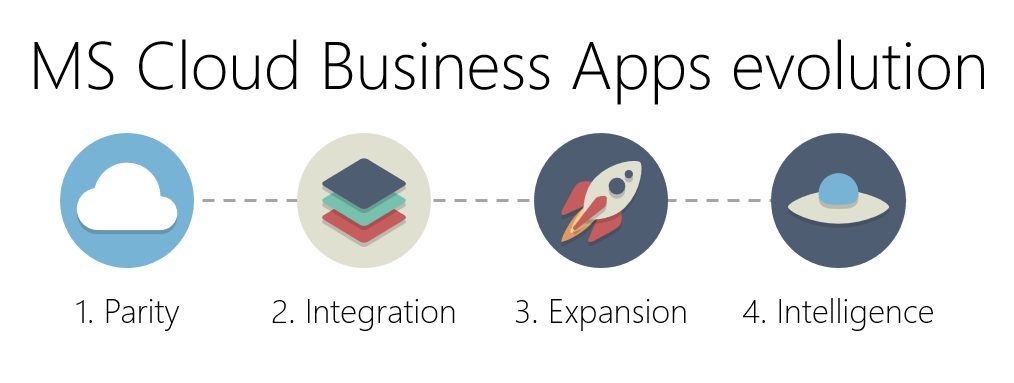Related sites:
Newsletter: Perspectives on Power Platform
Company: Niiranen Advisory Oy

In the past I’ve written about the History of Microsoft CRM from it’s first 10 years. I’ve also explored how the platform evolution up until Dynamics CRM 2013 had changed the product and how we worked with it. This time I want to focus on specifically the Microsoft Cloud era.
I started to think about the different focus areas that we’ve seen on the journey that’s taken us from the early CRM Online days into what the current roadmap for Dynamics 365 and the greater Power Platform look like. In my mind these “snap” into four logical stages that describe what the main ambition at any given time seems to have been for Microsoft’s product team:

Why bother looking back? Well, I could insert a “those who cannot learn from history” quote here, but really it’s more about putting the present into perspective. There are still plenty of customers who’ve either stayed with Dynamics CRM on-premises (now 365 CE by name, too) or who are still viewing the online service as just a “CRM in the cloud”. Hopefully this post will help in understanding the magnitude of change that has taken place in the greater Microsoft cloud during the past few years and why it would be better for them to embrace it rather than just observe it.
The very first versions of Dynamics CRM Online in 2008 wasn’t exactly the same product that you could get by installing it on your own application servers. The limitations on features and customizability meant this was a “CRM lite” that saved you the effort of infrastructure investments and server management, but there were a lot of trade-offs. You gotta start somewhere, but obviously this wasn’t exactly up to the vision that Microsoft saw as what the cloud services should offer to their customers.

Upon the global launch of Online we received the updated CRM 2011 version and most importantly the solution framework that after several iterations now powers the ALM story behind Power Platform. Closing down the gaps between Online and on-prem was the primary goal for product development, with the “Power of Choice” being a key selling point against server-only or cloud-only competition.
While the customization capabilities in CRM Online were surprisingly powerful already in 2011, the gaps in actually managing the environments you had no direct access to took a longer time to close. For the enterprise customers to consider moving from fully controlled servers and databases to the MS hosted cloud, a lot of investment was needed in building self-service features for instance management – not to mention ensuring the cloud apps were reliably available and updated in a controlled manner.
Today the flexibility of spinning up new instances, copying them for test & dev, taking backups, syncing data to Azure SQL for reporting, and many other self-service features available for admins make the cloud environment quite attractive. In exchange of giving up full control over your servers and databases, you have the luxury of not having to think about them at all. There are no servers to patch up and keep running. As for the updates, it’s now a continuous delivery of new & improved features that puts an end to the concept of an upgrade project altogether. Sure, you’ll still need to do your part to ensure customer specific customizations and integrations keep working – that’s just another service that needs a continuous delivery mindset.
Once the cloud version was sufficiently close to the on-premises Dynamics CRM server, the next stage was all about making it better than on-prem. This was the era in which Office 365 was really taking over the business productivity market, so you could say the low-hanging fruit was in tapping into these existing services in the MS Cloud and making Dynamics CRM a more attractive application through those.

Sure, we had heard the “better together” story for Dynamics + Office already in the on-prem days, but this wasn’t exactly the way we today expect cloud apps to just work with one another. Complex server configuration tasks were surely a nice source of revenue for the IT consulting companies, since very few customers were able to know all the ins & outs of how to properly deploy an Internet Facing Deployment of your Dynamics CRM server and make it talk with other MS server products. From Microsoft’s perspective, having useful product features available for everyone in theory doesn’t scale into real world customer success if there simply isn’t enough skill out there to deploy everything the way MS engineers do it in their labs. Well, when it’s all run by MS from beginning to end, this made it a solvable problem.
Making common online services like Exchange and SharePoint available for Dynamics CRM admins to click & configure on their own was one key part of this journey. What this Cloud + Cloud combo also meant was that new features from the latest versions of each service could be rolled out at a much faster pace than the server bits could ever follow. Oh, and since all the services were by default available via the public Internet, mobile clients became an everyday tool for accessing your CRM information.
As the core CRM product features in the cloud became mature enough, there was a door opened for refactoring the original software designs from the server days into something more cloud native. Leveraging the next generation of Windows Server, a.k.a. Azure, meant that features like search indexing could be modernized by hooking into innovation from the neighboring product team. The boldest step was taken with V9 that finally moved the whole Dynamics 365 Customer Engagement online service on top of Azure.
Building a new level of scalability into the cloud service also became a target in this stage. As an example, the Adxstudio Portals that MS acquired were transformed to run purely on Azure services. Yeah, this meant the on-prem Portal had to be discontinued, but on the bright side, every Dynamics 365 CE customer can now be given a free Portal instance, whereas with the old model there wouldn’t have ever been enough server capacity available to even allow free trials of the product. This deeper integration of all Dynamics 365 components and the new serverless tech from Azure made the platform ready for much bigger things to come.
XRM was always about an extensible platform, but when sold as a CRM product rather than an application platform specifically, there were always plenty of conflicts in marketing, licensing, channel, customer expectations and so on. XRM was a reality for sure, but it didn’t “happen” in the true scale of business that it would have needed to within a huge company like Microsoft. During the MBS era, Dynamics remained firmly as a niche product in the vast Redmond portfolio and didn’t get enough attention from the market nor all the needed support from complementary product lines.

Instead of chasing the elusive CRM vendor market share, the current Microsoft leadership appears to have a very different agenda in mind compared to their predecessors. The world is already full of CRM suites but at the same time it’s full of manual processes being stitched together by Excels and emails. The addressable market for the aPaaS (application platform as a service) and the rise of tools suitable for the hands of citizen developers have surely caught the eyes of those with P&L responsibility in Redmond over the past few years. With the immense investments made into cloud and a few rounds of organization restructuring to support it, the path for braking onto the main arena was finally opened for XRM.
The formation of the Business Applications Group brought together not just all flavors of Dynamics but also PowerApps, Flow and Power BI. The merging of XRM with CDS last Spring turned the vision keynotes into concrete hard reality when the Dynamics 365 CE technology was introduced as the foundation for PowerApps and Flow development. Similarly, it was made clear that the future toolkit for customization and extension of Dynamics 365 CE would be PowerApps and Flow.
The professional business application platform known from the Dynamics brand has now been harnessed to also cater for the next 10 million developers who are coming not from the Visual Studio land but rather from the crowd of power users that have been working with these traditional business apps. It’s about adopting the developer mindset but from a whole different perspective than what the term had traditionally meant. In a recent interview on Steve Mordue’s blog, Alysa Taylor (Microsoft CVP, Business Applications and Global Industry) said that what the team is now doing for Business Applications reminds her of the incubation spirit that was very much a part of the Microsoft developer division in her previous roles:
“While Dynamics obviously is not an incubation business, it is one we are re-imagining, so it feels very much like a new business we’re bringing into the forefront of the Microsoft portfolio.”
Now “legacy” products like Project Online are being re-architected to run on top of Power Platform and new apps from the ERP side like Dynamics 365 for Talent are also built from the same components as what we used to know as XRM. The customization story for both Office 365 and Dynamics 365 now relies on a common set of tools. Everything lives in the cloud and is built to connect with as many other clouds as possible – not just the ones with Microsoft’s logo on them.
So, if these three stages are the road already traveled, what is Microsoft focusing on right now? Before we get there, it’s important to realize that the aforementioned efforts for developing cloud management tools, productivity app integrations or Power Platform footprint expansion are not “done”. These tracks will all continue to take the product far beyond it’s on-prem origins, but perhaps they won’t be the biggest evolutionary force driving the development in the next few years.

AI is the Big Bet that Microsoft is making – just like its competitors like Google are, too. In my analysis of Top 3 themes for Dynamics 365 in 2018, I lifted the AI journey as topic Nr. 3, but it wouldn’t be very surprising if the 2019 review will put it at the top spot. For it make it there, we of course need to see a lot more than just flashy marketing content & analyst generated hype on the impact of artificial intelligence for businesses of different shapes and sizes. The timeline of this transformation is still too blurry for me to place any significant personal bets, but one thing’s quite certain: it’s not a question of “if” but “when”. In the same vein as SaaS CRM was inevitable, so is SaaS AI – and that’s where the cards that MS is holding in its hand are nothing short of that “all in” moment.
For the Microsoft cloud, the “all in” moment was in 2010, according to the marketing pitch at events like Convergence 2010. When observed right at this moment in time, SaaS AI looks like the ultimate deliverable of what the business software’s years long journey into the cloud has made possible. There’s just no way that a packaged product like “Microsoft AI Server 2019, Enterprise Edition” would have ever made sense to pursue as a commercial offering aimed at a silo implementation in a corporate server rack somewhere. Lifting the isolated Office & Dynamics services from those racks onto the common cloud infrastructure that surely is the world’s single largest business applications environment turned things completely around: now it makes sense to infuse AI in absolutely every application that runs on this cloud platform. Not only because of the seamless connectivity between the applications, but because of the ocean of data.
“There is no AI without data” is a very accurate phrase from Steve Guggenheimer’s blog post on the AI journey that organizations need to embark on sooner rather than later. Steve talks about the challenges that have been faced with the earlier AI projects that companies tend to run as proof of concept implementations, separated from the operational business processes, with insufficient ROI generated from the initial work to justify scaling it further. To address this, we’re going to need a foundation that can serve as the common source of data for initially the BI efforts but later expanded into the AI realm. What’s also very crucial is the ability to demonstrate the benefits of AI to the wider organization as a part of their daily tasks, and this is where the SaaS AI delivered via products like Dynamics 365 comes into play. These apps won’t replace the need for customer specific software in delivering AI based insights and outcomes for processes and products unique to the company, but they’re likely to pave the way for organizational understanding of the value of more intelligent systems in every part of the business.

Looking at these four stages in the cloud journey, they are clearly interdependent on each other. None could not exist without the earlier stage of evolution. Each of them becomes a layer that appears to have a great impact on the potential business value that can be delivered from this software platform. The further we go, the smaller the relative footprint of any individual part like Dynamics CRM is in the greater puzzle, but the greater its role as an enabler for new products and features to come.
(Thanks to Nick Roach for these great icons.)
Hosk’s recommended Dynamics 365 and other articles January 2019
Quotes “New ideas emerge when you question the assumptions upon which a problem is based” Shane
[…] 4 Stages of MS Cloud Business Apps Evolution […]
Hosk’s recommended Dynamics 365 and other articles January 2019
Quotes “New ideas emerge when you question the assumptions upon which a problem is based”